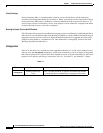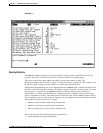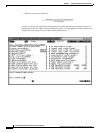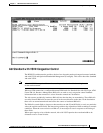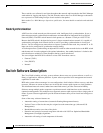
1-34
Cisco BPX 8600 Series Installation and Configuration
Release 9.3.10, Part Number 78-11603-01 Rev. D0, July 2001
Chapter 1 The BPX Switch: Functional Overview
Switch Software Description
These statistics are collected in real-time throughout the network and forwarded to the WAN Manager
workstation for logging and display. The link from the node to the Cisco WAN Manager workstation
uses a protocol to acknowledge receipt of each statistics data packet.
Refer to the Cisco WAN Manager Operations publication, for more details on statistics and statistical
alarms.
Node Synchronization
A BPX service switch network provides network-wide, intelligent clock synchronization. It uses a
fault-tolerant network synchronization architecture recommended for Integrated Services Digital
Network (ISDN). The BPX switch internal clock operates as a Stratum 3 clock per ANSI T1.101.
Because the BPX switch is designed to be part of a larger communications network, it is capable of
synchronizing to higher-level network clocks as well as providing synchronization to lower-level
devices. You can configure any network access input to synchronize the node. Any external T1 or E1
input can also be configured to synchronize network timing.
A clock output allows synchronizing an adjacent IGX switch or other network device to the BPX switch
and the network. In nodes equipped with optional redundancy, the standby hardware is locked to the
active hardware to minimize system disruption during system switchovers.
You can configure the BPX Service Node to select clock from these sources:
• External (T1/E1)
• Line (DS3/E3)
• Internal
Switch Software Description
The Cisco WAN switching cell relay system software shares most core system software, as well as a
library of applications, between platforms. System software provides basic management and control
capabilities to each node.
BPX node system software manages its own configuration, fault-isolation, failure recovery, and other
resources. Because no remote resources are involved, this ensures rapid response to local problems.
This distributed network control, rather than centralized control, provides increased reliability.
Software among multiple nodes cooperates to perform network-wide functions such as trunk and
connection management. This multiprocessor approach ensures rapid response with no single point of
failure. System software applications provide advanced features that you can install and configure as
required.
Some of the many software features are:
• Automatic routing of connections (Automatic Routing Management feature).
• Various Classes of Service that may be assigned to each connection type (Advanced CoS
Management).
• Bandwidth reservation on a time-of-day basis.
• Detection and control of network congestion with Abr with VSVD or Optimized Bandwidth
Management (ForeSight) algorithms.
• Automatic self-testing of each component of the node.



